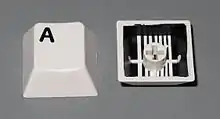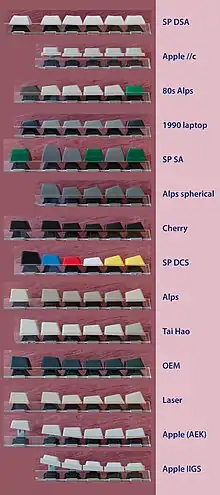Keycap
A keycap is a small plastic cover placed over the keyswitch of a computer keyboard. Keycaps are often illustrated to indicate the key function or alphanumeric character they correspond to. Early keyboards were manufactured with the keyswitch and keycap integrated in one unit; separate keycaps were introduced to facilitate the production of different keyboard layouts.


History
Typical keycaps in the 1970s and 1980s were produced using two-shot molding, with the markings molded into each keycap in a different color of plastic. This eventually fell out of favor, as it was more expensive (particularly in tooling costs), and tended to produce keycaps more durable than the equipment on which they were mounted. Modern keycaps are usually labelled by stamping or laser engraving. However, two-shot molding ("doubleshot") keycaps are still available today,[1] known for their feel[2] and general durability.
Modern keycaps
Keycaps can be bought in replacement sets for a keyboard. Notably, replacement sets are frequently sold for keyboards that use Cherry MX-style stems. Custom sets are bought and sold within the enthusiast communities, and artisan keycaps[3] can be purchased individually.
Keycaps are sold in printed and unprinted varieties. The unprinted variety, known as "Blank Keycaps," is said to promote touch typing and help build muscle memory because the user is forced to rely on motion rather than visuals. However, within the modern mechanical keyboard community, unprinted caps are typically chosen for their visual appeal.
The most common plastics used are ABS, PBT and POM (see the materials section). The top of most keycaps may be described as cylinder-shaped (curving to the sides as if a fat cylinder was resting on it), flat or spherical (curving to the top, bottom and sides as if a large sphere was resting on it). The modern preference is for cylinder-shaped keycaps rather than spherical ones, but laptop keys are often flat.
Construction
Materials
Keycaps materials vary among the brands and provide different feels, durability, damage resistance, and other properties.
| Material | Description |
|---|---|
| ABS | This is commonly used for keyboard casings and keys. It is a comparatively soft material compared to some modern plastics but is tough and resistant to breakage. Topre casings are made of ABS and IBM Model Ms are as well. Filco and Das keys are made of ABS as are most keys that ship with the keyboard purchased. It has a bit of a "slick" feeling. For example, Lego is made of ABS. [4] |
| PBT | PBT is a harder long-wearing material with a "sandier" feel and should not yellow as much as ABS over time. The downside is the brittle nature of PBT and expense, so most keyboard manufacturers do not use this for either keyboard cases or keys. Exceptions are some Cherry/Poker/Leopold keys and IBM/Unicomp keys. [5] |
| POM | Better known by the brand name "Delrin", it is an abrasion-resistant, solvent-resistant and low-friction material. However, it is expensive and not common. Found use in older black Cherry G80 keycaps and the discontinued Nopoo Chocolate keyboards. Keycool used to use with their keyboards but is now phasing it out. [6] Currently, Vortex is using POM as the lettering infill on their Backlit Doubleshot PBT/POM Keys.[7] Cherry MX key casings are made of POM Chemical Testing,[8] as are the stems Cherry Labeling on MY steB.[9] |
| PC | Tough clear plastic. Used for translucent keys like this Signature Plastic keyset.[10][11] |
Printing of characters
Printing of numbers, letters, and symbols on the keycaps is done using pad printing, laser etching, or dye sublimation.
| Material | Description |
|---|---|
| Pad printing | This is the cheapest and most common. |
| Dye sublimation | Dye sublimation is more expensive and only done by a few companies such as Topre, ZF Electronics (Cherry), and Unicomp. |
| Laser etching |
Key profile
As its name suggests, the easiest way to compare key profiles is to look at them from the side. The keyboard profile refers to the profile shapes of each row of keycaps. With different profiles, keys can vary in size, shape, and thickness. When (most) modern key sets vary in profile from row to row, this is called a sculptured profile.[12]

- OEM
- Cherry
- Apple
- Tai Hao
- Alps
- Laser
- DCS
- SA
- SA-P
- DSA
- HSA
- XDA
- MT3
| Look up keycap in Wiktionary, the free dictionary. |
Further reading
- US Utility 5193924, Larson, Carlyn F., "Cap cover for keyboard keys", issued 16 March 1993
References
- "DCS ABS Double Shot Sets". Pimpmykeyboard.com. Retrieved 2017-02-14.
- "What are the different keyboard keycaps?". Wooting developer blog. 2015-11-20. Retrieved 2017-02-14.
- "MechanicalKeyboards.com - The ultimate Mechanical Keyboard catalog". MechanicalKeyboards.com - The ultimate Mechanical Keyboard catalog. Retrieved 2017-02-14.
- "ABS".
- "PBT".
- "Keycool".
- "Vortex".
- "Cherry MX".
- "Reddit".
- "Translucent Keys".
- "Reddit".
- "Key profiles".